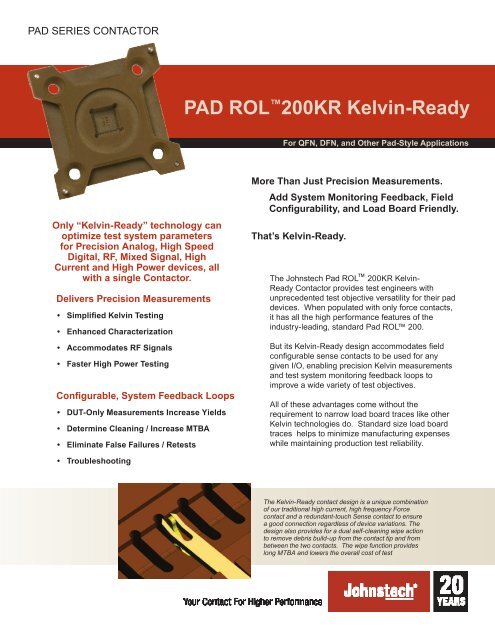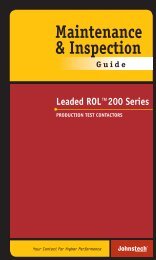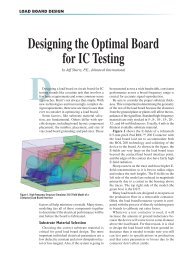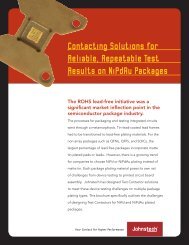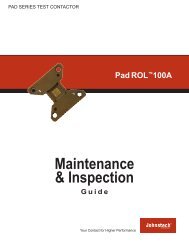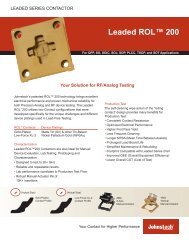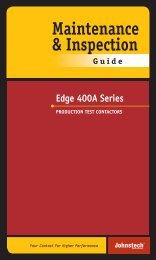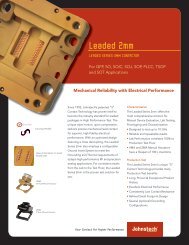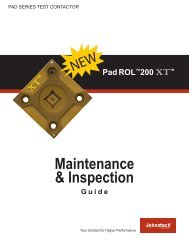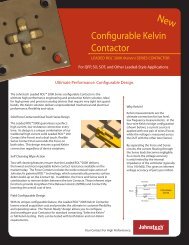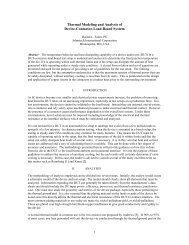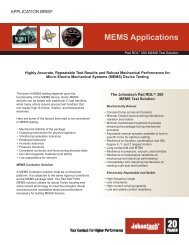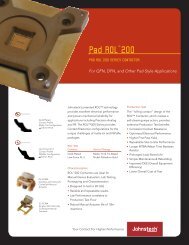PAD ROLâ¢200KR Kelvin-Ready - Johnstech
PAD ROLâ¢200KR Kelvin-Ready - Johnstech
PAD ROLâ¢200KR Kelvin-Ready - Johnstech
Create successful ePaper yourself
Turn your PDF publications into a flip-book with our unique Google optimized e-Paper software.
<strong>PAD</strong> SERIES CONTACTOR<br />
<strong>PAD</strong> ROL 200KR <strong>Kelvin</strong>-<strong>Ready</strong><br />
For QFN, DFN, and Other Pad-Style Applications<br />
Only “<strong>Kelvin</strong>-<strong>Ready</strong>” technology can<br />
optimize test system parameters<br />
for Precision Analog, High Speed<br />
Digital, RF, Mixed Signal, High<br />
Current and High Power devices, all<br />
with a single Contactor.<br />
Delivers Precision Measurements<br />
• Simplified <strong>Kelvin</strong> Testing<br />
• Enhanced Characterization<br />
• Accommodates RF Signals<br />
• Faster High Power Testing<br />
Configurable, System Feedback Loops<br />
• DUT-Only Measurements Increase Yields<br />
• Determine Cleaning / Increase MTBA<br />
• Eliminate False Failures / Retests<br />
More Than Just Precision Measurements.<br />
Add System Monitoring Feedback, Field<br />
Configurability, and Load Board Friendly.<br />
That’s <strong>Kelvin</strong>-<strong>Ready</strong>.<br />
The <strong>Johnstech</strong> Pad ROL 200KR <strong>Kelvin</strong>-<br />
<strong>Ready</strong> Contactor provides test engineers with<br />
unprecedented test objective versatility for their pad<br />
devices. When populated with only force contacts,<br />
it has all the high performance features of the<br />
industry-leading, standard Pad ROL 200.<br />
But its <strong>Kelvin</strong>-<strong>Ready</strong> design accommodates field<br />
configurable sense contacts to be used for any<br />
given I/O, enabling precision <strong>Kelvin</strong> measurements<br />
and test system monitoring feedback loops to<br />
improve a wide variety of test objectives.<br />
All of these advantages come without the<br />
requirement to narrow load board traces like other<br />
<strong>Kelvin</strong> technologies do. Standard size load board<br />
traces helps to minimize manufacturing expenses<br />
while maintaining production test reliability.<br />
• Troubleshooting<br />
The <strong>Kelvin</strong>-<strong>Ready</strong> contact design is a unique combination<br />
of our traditional high current, high frequency Force<br />
contact and a redundant-touch Sense contact to ensure<br />
a good connection regardless of device variations. The<br />
design also provides for a dual self-cleaning wipe action<br />
to remove debris build-up from the contact tip and from<br />
between the two contacts. The wipe function provides<br />
long MTBA and lowers the overall cost of test
<strong>Johnstech</strong> Pad ROL 200KR <strong>Kelvin</strong>-<strong>Ready</strong> Contactor Specifications<br />
<strong>Kelvin</strong>-<strong>Ready</strong> Load Board Design<br />
More Reliable, Less Expensive<br />
The Pad ROL 200KR <strong>Kelvin</strong>-<strong>Ready</strong> load board solution separates the<br />
Force and Sense load board traces in a front and back format, allowing<br />
standard size load board traces to route test signals.<br />
Unfortunately, side-by-side spring pin designs require twice as many<br />
traces in the same amount of space, resulting in narrow traces. Narrow<br />
traces reduce testing reliability and increase manufacturing complexity<br />
and expense (see images below and notice each layout has 12 force<br />
pads and 12 sense pads).<br />
On the other hand, the larger <strong>Kelvin</strong>-<strong>Ready</strong> traces maintain testing<br />
reliability and simplify load board design, reducing load board<br />
manufacturing expenses relative to other socket designs. For I/Os<br />
where <strong>Kelvin</strong> is not needed, removing the Sense line creates additional<br />
load board real estate and can also provide a straight line path to high<br />
speed connectors when testing RF and other high speed signals.<br />
Load Board Force and Sense Pad Comparison<br />
(each design has 12 Force and 12 Sense Pads)<br />
Manual Actuator<br />
· VMA (Vertical Manual Actuator)<br />
· ZMA (Z-Axis Manual Actuator)<br />
<strong>Johnstech</strong> Services/Resource Options<br />
· Test Floor Technical Support<br />
· Worldwide Field Service Offices<br />
· First-Pass Yield Enhancement<br />
· Performance Audits<br />
· Customized Training and Applications Engineering<br />
· Online Tech Support at: www.johnstech.com/support<br />
Engineering Services<br />
· Load Board Evaluation & Testing<br />
· Electrical Performance Analysis<br />
· Contactor S Parameter Data<br />
· Thermal Conductivity Analysis<br />
· PCB/Contactor/ Device Optimization<br />
· HFSS 3D Modeling<br />
· Advanced Design System (ADS)<br />
Website (www.johnstech.com)<br />
· Product, Test, Industry Support Information<br />
· Downloadable - Product Spec Sheets, Maintenance<br />
and Inspection Guides, Tech Papers and Application Notes.<br />
Methodology<br />
<strong>Kelvin</strong>-<strong>Ready</strong> Front/Back Design<br />
Spring Pin Side-by-Side Design<br />
Electrical<br />
Specifications<br />
Force Contact<br />
(non-<strong>Kelvin</strong>)<br />
Force + Sense<br />
(<strong>Kelvin</strong>)<br />
Electrical Length 2.00 mm 2.00 mm<br />
Inductance:<br />
Self: 0.47 nH<br />
Self: 3.5 nH<br />
Mutual: 0.10 nH Mutual: 0.77 nH<br />
Capacitance:<br />
Ground: 0.16 pF Ground: 0.85 pF<br />
Mutual: 0.06 pF Mutual: 0.25 pF<br />
S 21<br />
Insertion Loss/<br />
Bandwidth (GSG):<br />
-1 dB @ 19.9 GHz -1dB @ 3.0 GHz<br />
S 11<br />
Return Loss/<br />
Bandwidth (GSG):<br />
-20 dB @ 7.8 GHz -20dB @ 0.8 GHz<br />
S 41<br />
Crosstalk/Bandwidth<br />
(GSSG):<br />
-20 dB @ 34.7 GHz -20dB @ 17.3 GHz<br />
Average Contact DC 40 mΩ Force<br />
Resistance:<br />
330 mΩ Sense<br />


